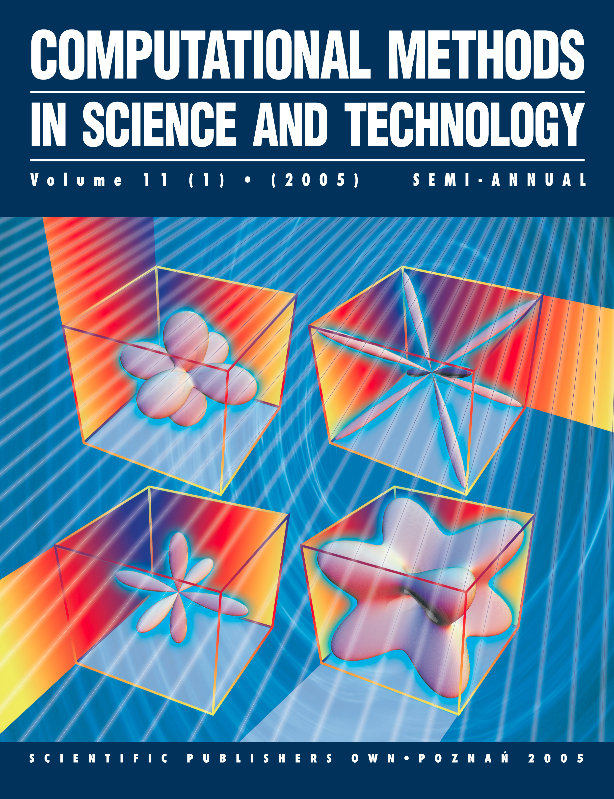THE STRUCTURE OF POROUS AND SPONTANEOUSLY DENSIFIED AMORPHOUS PbSiO3: A MOLECULAR DYNAMICS STUDY
Chomenko Katarzyna 1, Bergmański Grzegorz 1, Białoskórski Michał 1,2, Rychcik-Leyk Monika 1, Feliziani Sandro 3, Frigio Sandro 3, Witkowska Agnieszka 1,2, Rybicki Jarosław 1,2
1 Department of Solid State Physics, Faculty of Technical Physics and Applied Mathematics
Gdansk University of Technology, Narutowicza 11/12, 80-952 Gdansk, Poland
2TASK Computer Centre, Narutowicza 11/12, 80-952 Gdansk, Poland
3Istituto di Matematica e Informatica, Universitâ di Camerino
Camerino (MC), Italy
Received:
Rec. 6 May 2004
DOI: 10.12921/cmst.2004.10.01.21-38
OAI: oai:lib.psnc.pl:557
Abstract:
In the paper we propose and test a “gel-drying” method of obtaining porous oxide glasses in
Molecular Dynamics (MD) simulations. The simulation is started with low (screened) values of ionic charges. Then, the charges are gradually increased (to mimic the gradual elimination of a polar solvent) up to full ionic charges (a completely dry gel). This computational trick is applied to produce a porous PbSiO3 system. The structure of the resulting low-density samples is analysed in detail. Then, the porous structures are submitted to spontaneous densification, and the structure of the obtained dense bulk glasses is analysed. Finally, the structures of bulk glass obtained via spontaneous densification (density ρ = 8250 kg/m3) and bulk glass of the same density obtained via isotropic compression are compared.
References:
[1] W. G. Hoover, Molecular Dynamics, Lecture Notes in Physics, Springer-Verlag, Berlin, Heidelberg, New York 258 (1986).
[2] M. P. Allen and D. J. Tildesley, Computer Simulation of Liquids, Oxford (1997).
[3] R. W. Hockney and J. W. Eastwood, Computer Simulations Using Paricles, Moscow (in Russian) (1987)
[4] C. R. A. Catlow, Computer Simulation of Solids, Lecture Notes in Physics, Springer-Verlag,
Berlin, Heidelberg, New York, 166 (1982).
[5] D. C. Rapaport, The Art of MolecularDynamics Simulation, Cambridge (1995).
[6] A. Rybicka, J. Rybicki, A. Witkowska, S. Feliziani, and G. Mancini, Comput. Meth. Sci. Technol. 5, 67 (1999).
[7] J. Rybicki, A. Rybicka, A. Witkowska, G. Bergmański, A. Di Cicco, M. Minicucci, and G. Mancini, J. Phys. CM 13, 9781 (2001).
[8] J. Rybicki, A. Witkowska, G. Bergmański, G. Mancini, and S. Felizaini, The structure of
Pb-PbO-SiO2 glass via molecular dynamics, TASK Quart. 7, 243 (2003).
[9] G. Bergmański, M. Białoskórski, M. Rychcik-Leyk, A. Witkowska, J. Rybicki, G. Mancini,
S. Frigio, and S. Feliziani, TASK, Quart. 8, (3) 393 (2004)..
[10] A. Rybicka, The Structure and properties of lead-silicate and lead-germanate glasses, PhD
Thesis, Politechnika Gdańska (1999).
[11] http://www.uci.agh.edu.pl/alda/mdsim.
[12] A. Filipponi and A. Di Cicco, Phys. Rev. B 51, 12322 (1995).
[13] A. Filipponi, J. Phys. Cond. Matter 13, R23 (2001).
[14] D. S. Yang, D. R. Fazzini, T. I. Morrison, L. Troger, and G. Bunker, J. Non-Cryst. Solids 210, 275 (1997).
[15] G. Bergmański, J. Rybicki, and G. Mancini, TASK Quart. 4, 555 (2000).
[16] J. Rybicki, G. Bergmański, and Mancini, J. Non-Cryst. Solids 293-295, 758 (2001).
[17] http://www.task.gda.pl/software/anelli,
[18] G. Mancini, TASK Quart. 1, 89 (1997).
[19] R. Balducci and R. S. Pearlman, J. Chem. Inf. Comput. Sci. 34, 822 (1994).
[20] G. Mancini, J. Phys. Commun. 143, 187 (2002).
In the paper we propose and test a “gel-drying” method of obtaining porous oxide glasses in
Molecular Dynamics (MD) simulations. The simulation is started with low (screened) values of ionic charges. Then, the charges are gradually increased (to mimic the gradual elimination of a polar solvent) up to full ionic charges (a completely dry gel). This computational trick is applied to produce a porous PbSiO3 system. The structure of the resulting low-density samples is analysed in detail. Then, the porous structures are submitted to spontaneous densification, and the structure of the obtained dense bulk glasses is analysed. Finally, the structures of bulk glass obtained via spontaneous densification (density ρ = 8250 kg/m3) and bulk glass of the same density obtained via isotropic compression are compared.
[1] W. G. Hoover, Molecular Dynamics, Lecture Notes in Physics, Springer-Verlag, Berlin, Heidelberg, New York 258 (1986).
[2] M. P. Allen and D. J. Tildesley, Computer Simulation of Liquids, Oxford (1997).
[3] R. W. Hockney and J. W. Eastwood, Computer Simulations Using Paricles, Moscow (in Russian) (1987)
[4] C. R. A. Catlow, Computer Simulation of Solids, Lecture Notes in Physics, Springer-Verlag,
Berlin, Heidelberg, New York, 166 (1982).
[5] D. C. Rapaport, The Art of MolecularDynamics Simulation, Cambridge (1995).
[6] A. Rybicka, J. Rybicki, A. Witkowska, S. Feliziani, and G. Mancini, Comput. Meth. Sci. Technol. 5, 67 (1999).
[7] J. Rybicki, A. Rybicka, A. Witkowska, G. Bergmański, A. Di Cicco, M. Minicucci, and G. Mancini, J. Phys. CM 13, 9781 (2001).
[8] J. Rybicki, A. Witkowska, G. Bergmański, G. Mancini, and S. Felizaini, The structure of
Pb-PbO-SiO2 glass via molecular dynamics, TASK Quart. 7, 243 (2003).
[9] G. Bergmański, M. Białoskórski, M. Rychcik-Leyk, A. Witkowska, J. Rybicki, G. Mancini,
S. Frigio, and S. Feliziani, TASK, Quart. 8, (3) 393 (2004)..
[10] A. Rybicka, The Structure and properties of lead-silicate and lead-germanate glasses, PhD
Thesis, Politechnika Gdańska (1999).
[11] http://www.uci.agh.edu.pl/alda/mdsim.
[12] A. Filipponi and A. Di Cicco, Phys. Rev. B 51, 12322 (1995).
[13] A. Filipponi, J. Phys. Cond. Matter 13, R23 (2001).
[14] D. S. Yang, D. R. Fazzini, T. I. Morrison, L. Troger, and G. Bunker, J. Non-Cryst. Solids 210, 275 (1997).
[15] G. Bergmański, J. Rybicki, and G. Mancini, TASK Quart. 4, 555 (2000).
[16] J. Rybicki, G. Bergmański, and Mancini, J. Non-Cryst. Solids 293-295, 758 (2001).
[17] http://www.task.gda.pl/software/anelli,
[18] G. Mancini, TASK Quart. 1, 89 (1997).
[19] R. Balducci and R. S. Pearlman, J. Chem. Inf. Comput. Sci. 34, 822 (1994).
[20] G. Mancini, J. Phys. Commun. 143, 187 (2002).

